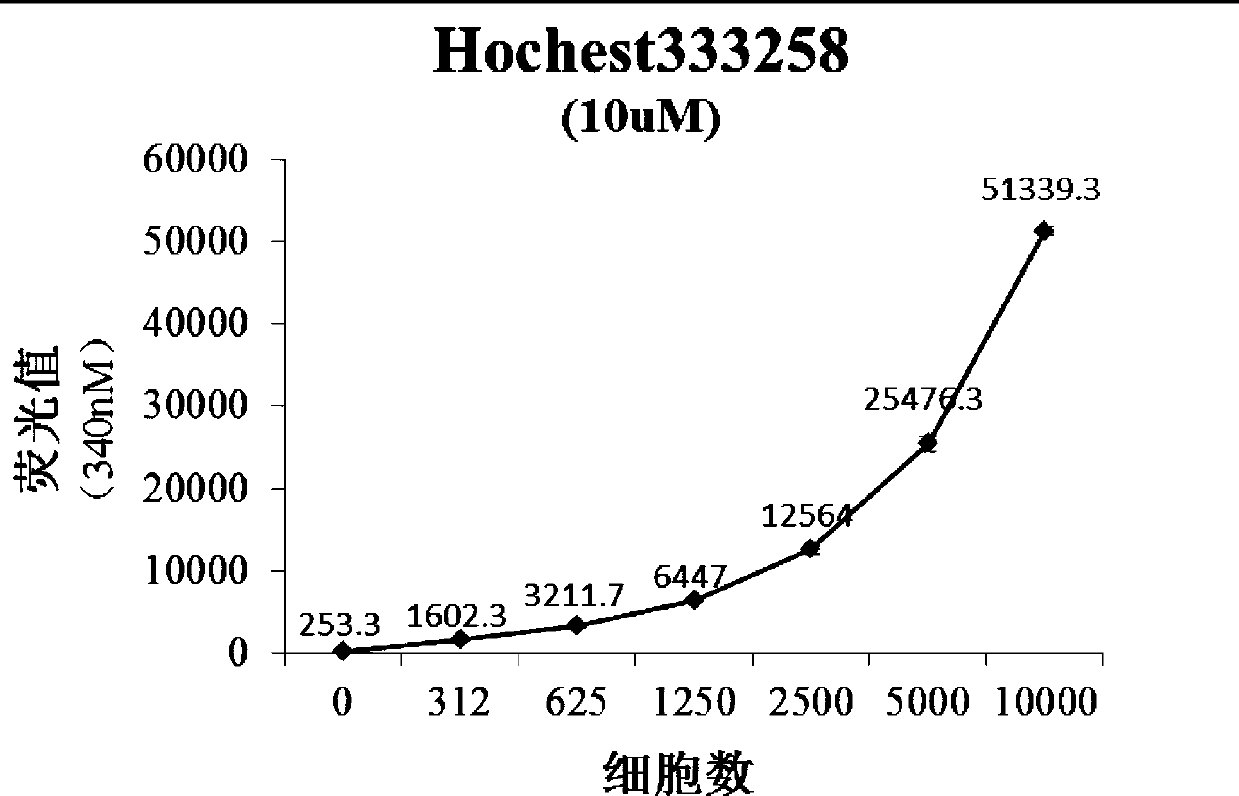Tumor cell proliferation detection method based on Hochest333258 and application
A tumor cell proliferation and tumor cell technology, which is applied in the field of cell proliferation detection based on Hochest333258 labeled tumor cells, can solve the problems of large experimental errors, increased experimental errors, and many processing steps, and achieves easy storage and use, stable experimental results, Instruments requiring simple effects
- Summary
- Abstract
- Description
- Claims
- Application Information
AI Technical Summary
Problems solved by technology
Method used
Image
Examples
Embodiment 1
[0035] 1) Dissolve Hochest333258 in 50% DMSO to make a mother solution with a concentration of 10mM;
[0036] 2) subculture human non-small cell lung cancer A549 cells into 96-well cell culture plates, count the number of cells and then dilute them to 10000, 5000, 2500, 1250, 625, 312 per well, respectively set up four duplicate wells, Then routinely culture in DMEM medium containing 10% calf serum (humidity 95%, temperature 37° C., 5% CO 2 ) for 24 hours. Then Hochest333258 was added to the cell culture medium to a final concentration of 10 μM. After mixing, place at room temperature for 10 minutes, then discard the cell culture medium, wash off the residual medium with PBS buffer, and then add 100 μL / well of PBS buffer. The wells without cell culture but added with 100 μl / well of PBS buffer were used as blank control, and the fluorescence value was detected at a wavelength of 340 nm using a fluorescent microplate reader.
[0037] Then two independent experiments were carri...
Embodiment 2
[0042] Other cases of tumor cell proliferation detection:
[0043] 1) Subculture human breast cancer MCF-7 cells, human cervical cancer Hela cells, and mouse melanoma B16-F1 cells to 96-well cell culture plates respectively, and after counting the number of cells, doubling according to the method described in Example 1 Dilution, cell culture.
[0044] 2) The cell nuclei were stained with the same concentration of Hochest333258 by the method described in Example 1, and the fluorescence intensity and relative fluorescence intensity of the cells were analyzed.
[0045] 3) The fluorescence value and relative fluorescence intensity of MCF-7, Hela and B16-F1 cells are as follows Figure 4 and 5 shown, where Figure 5 In each group of histograms, the left one is MCF-7 cells, the middle one is Hela cells, and the right one is B16-F1 cells. As the cell number increases, the fluorescence of MCF-7, Hela and B16-F1 cells The values and relative fluorescence intensities also increase...
PUM
 Login to View More
Login to View More Abstract
Description
Claims
Application Information
 Login to View More
Login to View More - Generate Ideas
- Intellectual Property
- Life Sciences
- Materials
- Tech Scout
- Unparalleled Data Quality
- Higher Quality Content
- 60% Fewer Hallucinations
Browse by: Latest US Patents, China's latest patents, Technical Efficacy Thesaurus, Application Domain, Technology Topic, Popular Technical Reports.
© 2025 PatSnap. All rights reserved.Legal|Privacy policy|Modern Slavery Act Transparency Statement|Sitemap|About US| Contact US: help@patsnap.com



